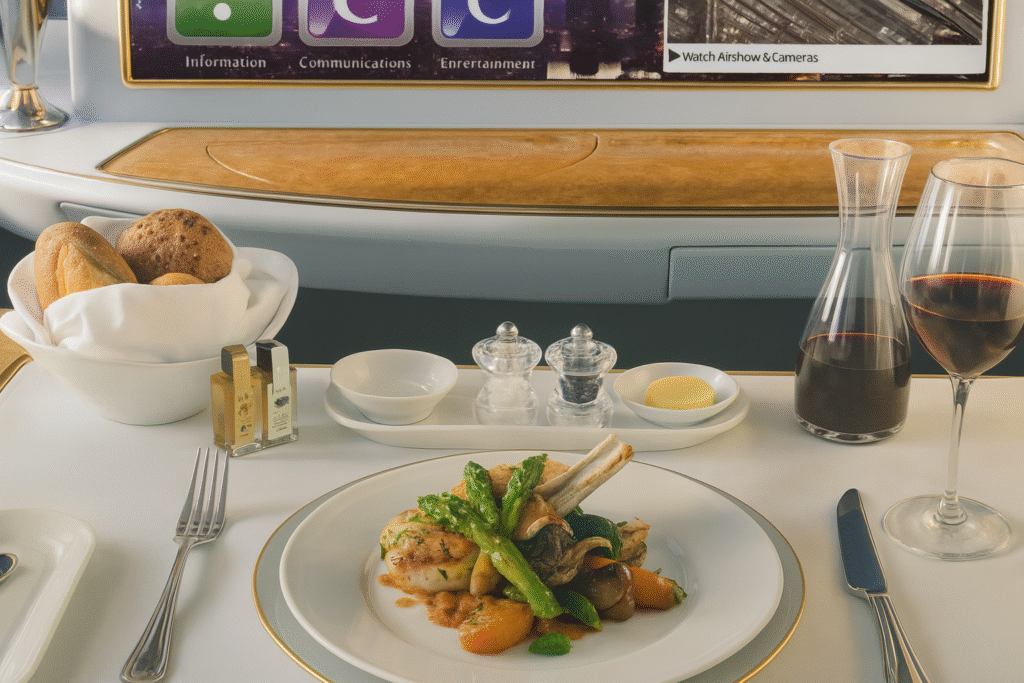When it comes to air travel, few things ignite as much curiosity — or skepticism — as airplane food. Once derided for its soggy textures and uninspired flavors, in-flight meals have experienced a quiet revolution over the past two decades. At the forefront of this culinary renaissance stands Emirates, widely hailed as the “king of the cabin kitchen.” With 85% of passengers rating their meals positively and 84% praising their snacks and beverages, Emirates has transformed what it means to dine at 35,000 feet.
The Legacy of In-Flight Dining
To understand how Emirates rose to culinary supremacy, we must first glance at the humble beginnings of in-flight meals. Early commercial air travel in the 1920s and 1930s featured little more than cold sandwiches and flasks of coffee, served in rattling cabins with minimal service. By the post-war era, airlines began to compete for elite passengers through luxurious offerings, including prime cuts of meat, vintage wines, and multi-course dinners.
In the 1970s and 1980s, however, cost-cutting and the democratization of air travel often led to a decline in meal quality, especially in economy class. The “rubber chicken” stereotype took hold, and for decades, many travelers resigned themselves to culinary mediocrity above the clouds.
Enter Emirates: A New Culinary Standard
Founded in 1985, Emirates rapidly positioned itself as a symbol of luxury and innovation. While other airlines focused on squeezing in more seats or shrinking legroom, Emirates understood that food was an essential part of the travel experience — a moment to impress, delight, and distinguish itself from the competition.
The Dubai-based carrier set out to design meals that reflected its global routes and diverse clientele. Whether flying from Dubai to Tokyo or from Milan to New York, passengers could expect thoughtfully curated menus showcasing both local and international flavors. From aromatic chicken biryani to saffron-infused fish stews, Emirates’ meals felt more like restaurant plates than airplane fare.
Farm-to-Plane Philosophy
A major factor behind Emirates’ culinary success is its commitment to fresh, high-quality ingredients. The airline is invested in Bustanica, the world’s largest vertical farm, located near Dubai. This cutting-edge facility produces over 1 million kilograms of leafy greens annually without pesticides, herbicides, or soil, ensuring that passengers enjoy crisp salads and garnishes even when flying halfway around the world.
Such farm-to-plane initiatives not only guarantee freshness but also reduce supply chain vulnerabilities — a lesson airlines learned sharply during global crises. Emirates’ ability to control its ingredient sourcing has set a new benchmark for sustainability and consistency.
The Art of Menu Crafting
Emirates doesn’t leave its menu to chance. The airline collaborates with top international chefs and in-house culinary experts to create regionally tailored menus. For instance, flights departing from Japan might feature miso-marinated black cod and soba noodles, while those leaving Italy could include truffle ravioli or panna cotta with berry coulis.
In business and first class, the experience is elevated even further. Passengers can savor caviar service, artisan cheeses, and premium wines from Emirates’ impressive cellar. According to the airline, it has invested over $700 million in its wine program, which includes vintage bottles from renowned châteaux in Bordeaux and Burgundy.
Economy Class: Where Emirates Truly Shines
While premium cabins often receive the most attention, Emirates refuses to neglect its economy passengers. Full hot meals, carefully designed trays, and thoughtfully chosen desserts and bread rolls elevate the experience far above the industry standard.
It’s not just about the main course — even details like metal cutlery (in many cases) and freshly baked bread make a difference. Passengers frequently report that the overall meal presentation feels special, almost ceremonial, breaking up long flights and creating small moments of joy.
Beverage Excellence
Emirates’ drink selection deserves its own spotlight. In addition to a wide array of juices, soft drinks, and teas, the airline offers an impressive range of wines and spirits in all classes. The bar onboard its A380 aircraft has become iconic — a social hub at 40,000 feet where travelers can sip Champagne, enjoy expertly mixed cocktails, and snack on canapés while mingling.
Even in economy, Emirates provides a generous selection of complimentary wines and beers, a rarity among many international carriers today.
Responding to New Trends
Modern passengers are more discerning and health-conscious than ever before. Emirates has responded with increased vegan, vegetarian, gluten-free, and other special dietary options. Plant-based meals, for example, have evolved from afterthoughts into carefully crafted dishes featuring quinoa salads, tofu stir-fries, and even dairy-free desserts.
Additionally, Emirates has embraced regional culinary trends. On certain routes, passengers can taste Emirati specialties like lamb machbous (a spiced rice dish) or luqaimat (sweet dumplings drizzled with date syrup).
Passenger Feedback and Continuous Improvement
Emirates’ remarkable passenger satisfaction scores (85% for meals, 84% for snacks and drinks) aren’t just marketing boasts; they reflect a consistent feedback loop. The airline regularly surveys travelers and uses this data to refine recipes, portion sizes, and even tray layouts. In a travel landscape where airlines often slash amenities to save costs, Emirates’ investment in passenger experience stands out.
Cultural Diplomacy at 35,000 Feet
Beyond taste, Emirates’ approach to food serves as a form of cultural diplomacy. By highlighting regional flavors and introducing global passengers to Middle Eastern hospitality, Emirates acts as an ambassador for Dubai and the broader region. The airline subtly weaves stories of its home city into each dish, encouraging travelers to explore Dubai’s culinary landscape when they land.
A Template for the Future
As air travel rebounds and evolves post-pandemic, passengers will continue to expect more than just a seat and a safe arrival. Food will remain a central element of brand differentiation and loyalty. Emirates has demonstrated that with creativity, investment, and respect for passengers’ palates, an airline can transform an otherwise dreaded part of the journey into a memorable highlight.
Impresson
In the end, Emirates doesn’t just feed passengers; it invites them into a story, a journey within a journey. It’s a reminder that even at cruising altitude, thousands of miles from home, it’s possible to find warmth, comfort, and connection through food.
With its unwavering dedication to quality, innovation, and hospitality, Emirates rightfully holds its crown as the king of the cabin kitchen — proving that the soul of travel isn’t just in the destination, but in the flavors we encounter along the way.
No comments yet.







